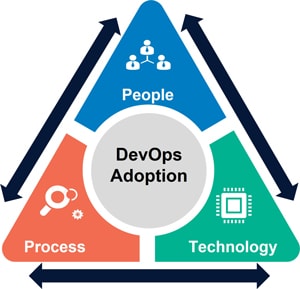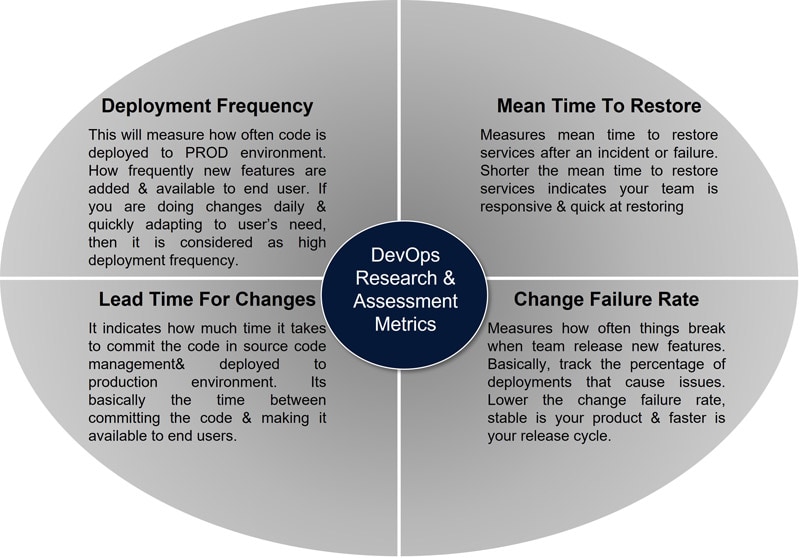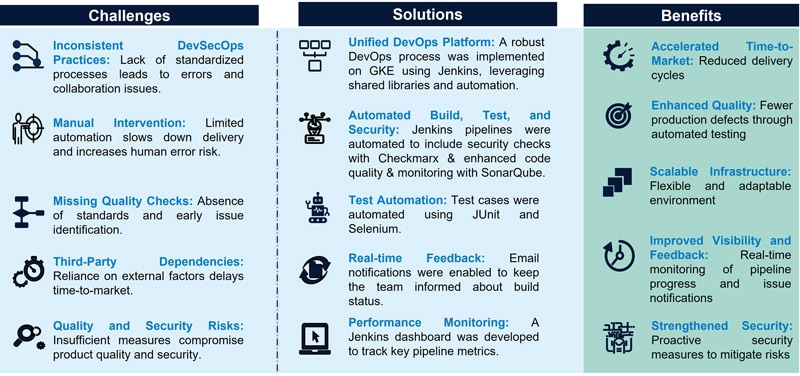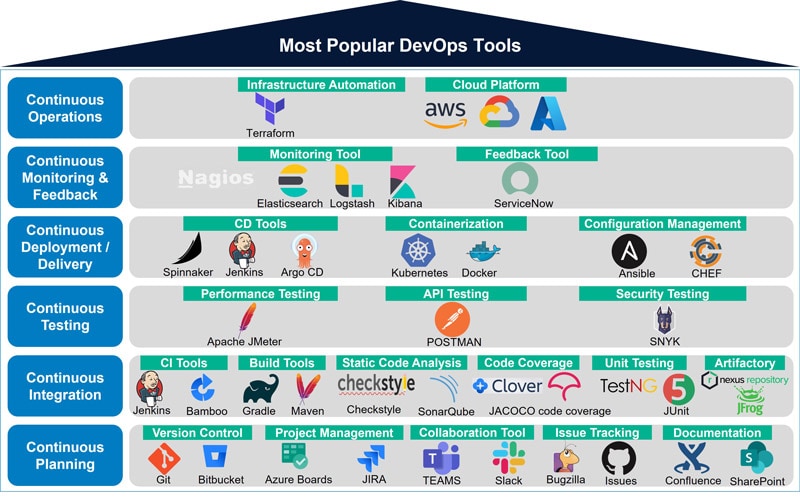DevSecOps
DevOps Revolution
This whitepaper will help the audience to understand DevOps principles, its lifecycle and how to adopt DevOps. It will also emphasize on best practices for successful implementation of DevOps and how it fosters collaboration, drives automation and accelerates software delivery.
Insights
- DevOps empower organizations to streamline workflows and deliver high-quality software.
- Through the 7Cs of DevOps Lifecycle, leveraging best practices and choosing the right CICD tool enhance agility and efficiency.
- A Real use case highlights how DevOps reduces deployment times, minimizes error and drives innovation in complex IT environments.
Introduction
In today’s fast paced software development environment, business demands organization wide DevOps adoption that ensures continuous integration and continuous delivery by embedding automated Security governance. DevOps has emerged as a pivotal practice in modern software engineering. It is bridging the gap between development and operations teams.
DevOps lifecycle
DevOps lifecycle consists of 7Cs.
Figure 1: DevOps Lifecycle

- Continuous Planning: This phase involves planning and developing the software. Development is broken into smaller tasks, following Agile methodologies that focus on “just-in-time” requirements. It includes defining user stories and refining the product backlog.
- Continuous Integration: In this phase, developers write code and push changes to the source code management system. All code changes are merged frequently and validated through automated builds, tests, and security checks. This helps the team identify issues early in the development process.
- Continuous Testing: This phase involves writing and running automated test cases using various tools such as Selenium, JUnit, and TestNG.
- Continuous Deployment: In this phase, application code is automatically deployed to production environments, facilitating seamless delivery.
- Continuous Monitoring: This ensures that systems and applications are continuously monitored to detect any bottlenecks, performance issues, or downtime. Alerts can be set to notify the stakeholders so necessary actions can be taken.
- Continuous Feedback: This crucial phase involves gathering feedback from all stakeholders, including developers, testers, product owners, and end users. This helps the team identify what went well and what can be improved.
- Continuous Operations: This ensures that systems are available 24/7. It focuses on building highly available and scalable infrastructure through automation.
How to Adopt DevOps in Project
DevOps adoption is break down into three key pillars – People, Process and Technology. The first step is to assess the current state of our processes, tools, and culture to identify areas of improvement.
Figure 2: DevOps Adoption

People Transformation:
DevOps emphasizes promoting collaboration and cross functional and fosters the mindset of shared responsibility between developer and operations team.
Key focus areas are:
- Knowledge and Skill Management: Teams are expected to be cross functional with each team member capable of handling multiple roles which will help to reduce a blame culture. Learning and reskilling should occur to ensure products align with user expectation. Offers Mentorship program to upskill team members and adopt best practices from mentor’s experience.
- Self-Managed Teams: Team should be self-organized and have the capability of decision making on how to achieve the desired goals.
- Shift-Left Mindset: Often, testing and security are neglected. So, encourage a shift left Mindset where testing and security governance will be considered early in the development phase.
Process Transformation:
Process transformation plays a significant role in DevOps adoption. Traditionally, accommodating changes in requirements later in the process is challenging because requirements are defined upfront during the initial phase. To avoid surprises at the end, agile methodologies are introduced, focusing on responding to change rather than strictly following a plan. This approach helps speed up the feedback loop and enables frequent releases. A proper understanding of DevOps principles is also essential.
Key focus areas are:
- Adopt Agile Practices: Use Agile methodologies such as Scrum, kanban /which helps to deliver the working software through sprints.
- End to End Automation: Automate the entire software development lifecycle including building the source code, Running tests, deployments, and monitoring.
- Continuous Improvement & Feedback Loops: Conduct sprint Retrospective meetings to discuss what went well and what can be improved and implement the feedback mechanism to identify issues early such as notifying developers and testers about issues or metrics via Teams or Slack.
Technology Transformation:
In DevOps, no single tool can meet all needs. Therefore, selecting the appropriate set of tools and infrastructure is an essential part for successful DevOps adoption. We must choose tools that can automate repetitive tasks and help us achieve DORA metrics, such as CI/CD pipelines, infrastructure as code, containerization, and monitoring solution.
Best Practices for Successful Implementation of DevOps
- Define a Branching Strategy: Ensure the Master branch is always up to date with all changes.
- No Direct Commits: Require pull requests for all changes and merge them into the main branch only after approval.
- Store Build Artifacts: Use an artifact repository for building artifacts instead of storing them in the source control management (SCM) system.
- Write Test Cases: Utilize methodologies like test-driven development (TDD), behavior-driven development (BDD), and acceptance-driven development (ADD). Ensure all test cases pass before checking in code to the source code repository.
- Achieve Maximum Code Coverage: Aim for high code coverage, as it indicates more lines of code are covered by automated test.
- Minimize Code Smells, Bugs, and Vulnerabilities: Prioritize and address the most impactful issues to maintain code quality.
- Build Code on Pull Requests: Automatically build the code whenever a pull request is raised, or changes are merged into a branch.
- Set up Feedback Mechanisms: Implement alerts to notify stakeholders if any stage fails.
- Use Deployment Strategies: Ensure the application remains up and running during deployments, zero downtime.
- Ensure Scalable and Highly Available Infrastructure: Make sure your infrastructure can auto-scale and maintain high availability.
DORA Metrics to Measure Success of DevOps
DORA Metrics can be used to Measure the DevOps success. It provides key insight into software development life cycle performance.
Figure 3: DevOps Research and Assessment Metrics (DORA) metrics

Case Study:
Company Background: It is the largest telecommunication network in Switzerland. It provides diverse services such as mobile, TV and landline phone and internet services.

Most Popular DevOps Tools

Conclusion
The adoption of DevOps is no longer a choice but a necessity in the fast-paced digital era. By integrating 7C’s framework, fostering a culture of collaboration ,leveraging right tool and technologies can help to achieve faster delivery cycle and improved quality.
References
Throughout the preparation of this whitepaper, information and insights were drawn from a range of reputable sources, including research papers, articles, and resources. Some of the key references that informed the content of this whitepaper include:
These references provided the foundation upon which the discussions, insights, and recommendations in this whitepaper were based.

Subscribe
To keep yourself updated on the latest technology and industry trends subscribe to the Infosys Knowledge Institute's publications
Count me in!









